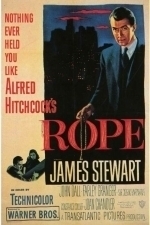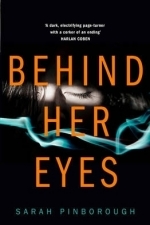Andy K (10823 KP) rated Rope (1948) in Movies
Sep 18, 2019
After the guests arrive, the usual small talk and chit chat commences with those attending including David fiance and a former college professor of the men. After the idle conversation starts to bore, it is mentioned how interesting it would be to murder someone and the consequences of doing so. It's no dig deal to dispose of people you don't like is it? Some party-goers are not keen on this conversation and lead it in a new direction eventually focusing on the missing David who has not yet arrived.
Eventually, the unresolved issue of David's absence is brushed aside for the moment and the guests leave to go about their lives. The college professor returns after having been given verbal clues in the former conversations about the nefarious activity of Phillip and David as well as some physical ones. He confronts the duo and David is unable to hold back.
The mystery has been revealed and the men have to deal with the fallout and consequences.
The physical limitation of the amount of film cameras of the day were able to hold was the only drawback for the way Hitchcock managed to shoot this film. There are only 10 total shots within the film ranging from 4 to 10 minutes. The cuts were achieved through normal editing, but also the actors and camera intersecting for brief moments where a momentary black frame would occur continuing the action right after this moment.
I can't even imagine the amount of rehearsal and takes would have been necessary for both the actors and production crew to orchestrate visual and vocal cues and not making mistakes for such a long time for each shot to be completed successfully. The film feels much like a stage production having all the scenes occur mainly in the living room and foyer areas, but that had to be by design.
With no elaborate staging, the audience is left to enjoy the masterful screenplay nonstop and trying to figure out if the two murderers will actually be able to dissuade blame or be confronted with the guilt.
One of many Jimmy Stewart's many Hitchcock collaborations, his performance mostly gets overlooked here in comparison to Vertigo and Rear Window; however, once he arrives at the party it is kind to see him and he delivers another captivating and motivated performance.
In the current days of digital filmmaking and continuous camera shots which can now be processed with computers, it is monumental Hitchcock was able to achieve this feat back in the day with only relentless dedication, but also precise and genius execution.

Liquid Personal Finance: drag & drop money to budget & track expenses
Finance and Education
App
Become one with your money. Liquid is the mobile app to know how much money you’ll have by the...

PayMobile for PayPal
Finance and Business
App
MULTIPLE ACCOUNTS support, OFFLINE preview and reporting, CREDIT CARDS TERMINAL, SUMMARY reports by...

Alarm Clock & Weather HD - Digital Night Stand for iPad
Travel and Weather
App
Alarm Clock is the most realistic alarm clock app ever made for the iPad. APPLE picks the Alarm...

Mancala HD
Games and Entertainment
App
As previously featured by Apple in "New and Noteworthy" and "Staff Favorites" In Russia they call...
Phillip McSween (751 KP) rated Go Back to China (2020) in Movies
Sep 3, 2020
Acting: 10
Great performances all around from a stellar Asian cast. While I don’t know much about them from previous films, I was extremely impressed with the range of Anna Akana, Richard Ng, and Lynn Chen who all shared the most screen time. They breathed a life and a realism into their characters that really made them feel like family.
Beginning: 2
Characters: 10
I appreciated that the three main characters experienced a great growth over the course of the movie. Each of them played off of each others’ personalities and experiences which gave the movie a true dynamic feel. The main character Sasha Li is likable right from jump even as a pretentious snob. She gives you a reason to stay interested in the movie.
Cinematography/Visuals: 6
The camera work is just slightly above par here. Outside of the toy factory, the setpieces are pretty bland. I honestly can’t remember any scenes that stand out or a shot that made my jaw drop. The movie instead seems content with going through the motions.
Conflict: 3
Entertainment Value: 6
Go Back to China is not without its share of entertaining moments but unfortunately those moments are too few and far between for the movie to consistently be entertaining. Just when it starts to get a bit of momentum, it finds itself going in reverse. Too much talking, not enough action. In the thick of it, it felt more like a Hallmark movie than anything else.
Memorability: 8
Pace: 8
The story moves along gracefully, albeit with a few trip-ups here and there. I always felt like the story was going somewhere at the very least. This would have worked more in the film’s favor had the story itself been a little more solid.
Plot: 5
As I mentioned above, the story definitely has a very Hallmarky-type feel. The cheese runs super high throughout. The premise is interesting, but things become very predictable very fast the longer the story plays out.
Resolution: 10
Say what you want about Hallmark movies, who doesn’t love a good Hallmark ending? All the pieces of the puzzle ended up exactly where they needed to be. If the movie had began just as strongly as it had ended, the movie would have been way more enjoyable.
Overall: 68
As a man that loves to appreciate and understand different cultures, I did love the perspective the movie provided into the life of people in China and the different hardships they face. Unfortunately, I didn’t love Go Back to China as a whole. A few tweaks here and there and this review would look a lot different.
Kristy H (1252 KP) rated Behind Her Eyes in Books
Oct 1, 2020
Louise has a pretty boring life. A single mom and part-time secretary, most of her life revolves around her young son. But then one night she meets a man in a bar and feels an instant attraction. Though it stops with a kiss, she feels excited by the prospect of finally having met someone. So imagine Louise's surprise when, the next morning, she sees the man again. At work. He's her new boss. And he's also very married, to a beautiful younger wife, Adele. Soon, Louise accidentally runs into Adele and the two form a friendship. Louise knows it's wrong, but she feels drawn to Adele as well. She appears lonely. Plus, the more Louise learns about Adele, the more she feels something is off: Adele seems afraid and almost controlled by David. Before she knows it, Louise is spending time with Adele and David, unable to tell the other about what she's doing. She's also realizing that there's something very wrong with this marriage. But how wrong, Louise has no idea.
"You can never know everything about a person. You'd go mad trying to."
Well, this was a spellbinding thriller. It's a wild ride that keeps you guessing the entire time, wondering who is twisting whose mind and what on earth is going on between David, Adele, and even Louise. Is David an abusive husband controlling his wife? Is Adele a cowed and crazy housewife? What happened between David and Adele when they were young and Adele's parents died? Is Louise complicit in their games? I felt befuddled and mesmerized as I madly flipped the pages, trying to figure out what on earth was going on.
"The more I fall for David, the more fascinated I become with Adele. It's a vicious circle."
I knew I didn't really like any of these people, but I didn't care, as I had to know what was going to happen next. Trying to put together the pieces in this psychological puzzle is nearly impossible; it seems like everyone is playing mind games with everyone else. It's told in a Now and Then format, with perspectives from Adele and Louise. But who can we trust? Does anyone tell the truth in this book? I won't spoil it for you, but I can say that the short chapters and flip in time periods make for a captivating read.
Some of the plot is strange and again, the characters are not particularly likeable (Louise, come on, let's make better choices), but the book makes up for it in psychological thrills and twists. Behind Her Eyes has been on my shelf for a while, as I'd heard about its surprises and big ending. I'm glad I used this challenge to pick it up. It was a different read and a crazy one. 3.75 stars, rounded to 4 here.

MyChair Salon Book Clients Appointments Manager
Business and Productivity
App
#1 Selling Salon Software app - MyChair is both iPhone & iPad app. More people choose MyChair over...

All Vegan Recipes
Food & Drink and Lifestyle
App
Looking for the best and most delicious vegan recipes? YOU'VE FOUND IT!! This incredible Vegan...

Bubble Bust! - Pop Bubble Shooter
Games and Entertainment
App
Over 25 million people around the world are playing this original arcade bubble shooter! Thank...


